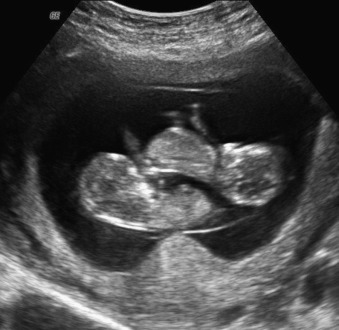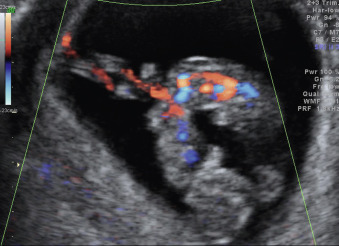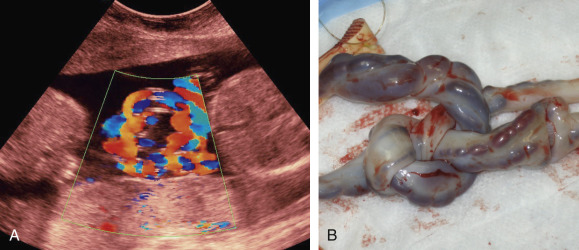Abstract
The term monochorionic refers to a multiple gestation with one placental disk (or chorion), whereas monoamniotic describes the presence of only one amniotic cavity. By definition, monoamniotic twin pregnancies are monozygotic. In the early first trimester, monochorionic monoamniotic twin pregnancies can be identified by the presence of one gestational sac and one amniotic sac containing two fetuses. Monochorionic monoamniotic pregnancies are characterized by the presence of two fetuses of the same gender, a single placenta, and the absence of an intertwin membrane. Ultrasound (US) detection of cord entanglement is diagnostic of a monoamniotic gestation. In addition to risk of preterm delivery and growth disorders present in all twin gestations, monochorionic monoamniotic pregnancies are at risk of congenital anomalies, twin transfusion syndrome, and an increased risk of perinatal mortality related to cord entanglement. Serial prenatal US scans and heightened prenatal surveillance are essential in the management of monoamniotic twin pregnancies.
Keywords
monoamniotic, monochorionic, twin, multiple pregnancy
Introduction
In addition to the general risks associated with twin pregnancies and with specific risks of monochorionic gestations, monoamniotic twin gestations face the unique risk of cord entanglement and are at increased risk of fetal demise. Ultrasound (US) plays a vital role in prenatal determination of chorionicity and amnionicity and in the prenatal management of monochorionic monoamniotic twin pregnancies.
Disease
Definition
The term monochorionic refers to a multiple gestation with one placental disk (or chorion), whereas the term monoamniotic describes the presence of a single amniotic cavity. A monochorionic monoamniotic twin pregnancy is one in which there is one shared placenta and a single amniotic sac containing two fetuses. By definition, monochorionic monoamniotic twin pregnancies are monozygotic.
Prevalence and Epidemiology
Although twin gestations accounted for almost 3.4% of live births in the United States in 2014, the estimated incidence of monoamniotic twins is only 1 : 10,000 pregnancies. The frequency of monozygotic twins is constant worldwide at 4 : 1000 births. More than two-thirds of monozygotic twin gestations have monochorionic placentation; however, monoamnionicity affects less than 5% of monozygotic twin gestations. The literature shows that monoamniotic gestations are more common following assisted reproductive technologies such as intracytoplasmic sperm injection.
Etiology and Pathophysiology
Monozygotic twinning results from the division of a single fertilized ovum into two distinct fetuses. Chorionicity and amnionicity of monozygotic gestations are determined by the time at which division of the fertilized ovum occurs. If twinning occurs during the first 2 to 3 days, it precedes the separation of cells that eventually become the chorion and results in a dichorionic diamniotic pregnancy. After approximately 3 days, twinning cannot split the chorionic cavity, and division of an ovum results in monochorionic placentation. If the split occurs between the third and eighth days, a monochorionic diamniotic pregnancy develops; monochorionic monoamniotic pregnancies result from divisions that occur between the eighth and twelfth days. Embryonic cleavage between the 13th and 15th days results in conjoined twins; splitting does not occur beyond the 15th day of gestation.
Manifestations of Disease
Clinical Presentation
Multifetal gestations should be suspected if the uterine size is greater than expected. Similarly, the possibility of a multiple gestation should be considered if elevated concentrations of maternal serum analytes, such as beta-human chorionic gonadotropin, alpha-fetoprotein, and other serum aneuploidy markers, are noted in the first or second trimester. When a multiple gestation is suspected clinically, US should be performed to assess plurality, and if a multiple gestation is confirmed, to determine chorionicity and amnionicity. There are no non-US clinical findings that can differentiate monoamniotic multiple gestations from diamniotic multiples.
Imaging Technique and Findings
Ultrasound.
In the first trimester, monochorionic twin pregnancies can be easily detected on US. Between 6 and 10 weeks’ gestation, a monochorionic twin pregnancy can be identified by the presence of a single gestational sac containing two fetuses. The presence or absence of an intertwin membrane may be difficult to determine in the middle of the first trimester ( Fig. 159.1 ); however, the number of yolk sacs can also be used as an indirect method of determining amnionicity early in gestation. The presence of a single yolk sac suggests a monoamniotic twin pregnancy ( Fig. 159.2 ), whereas the finding of two yolk sacs is diagnostic of a diamniotic twin pregnancy.


Later in gestation, monochorionic monoamniotic pregnancies can be differentiated from other types of twin pregnancies through a systematic evaluation of the placental number, fetal gender, and intertwin membrane. Specifically, monochorionic monoamniotic pregnancies are characterized by the presence of two fetuses of the same gender with a single placenta, single amniotic sac, and no intertwin membrane.
When attempting to determine amnionicity of a monochorionic gestation, lack of visualization of an intertwin membrane in a monochorionic pregnancy has relatively low positive predictive value for the diagnosis of a monoamniotic gestation. This low positive predictive value is likely explained by the fact that the thin intertwin membrane of monochorionic gestations may be difficult to visualize on US. It is significantly more difficult to visualize the intertwin membrane of monochorionic pregnancies complicated by oligohydramnios because the intertwin membrane may become so closely apposed to the fetus in that sac that it becomes undetectable on US. A “stuck twin” appearance results, with the trapped fetus remaining firmly held against the uterine wall despite changes in maternal position. Diagnosis of this condition confirms the presence of a diamniotic gestation, which should be distinguished from a monoamniotic gestation with an absent dividing membrane.
In addition, visualization of cord entanglement is diagnostic of a monochorionic monoamniotic twin gestation ( Fig. 159.3 ; see Fig. 159.2 ). The placental cord insertions of monochorionic twins may be within close proximity of each other ( Fig. 159.4 ).


Stay updated, free articles. Join our Telegram channel

Full access? Get Clinical Tree








